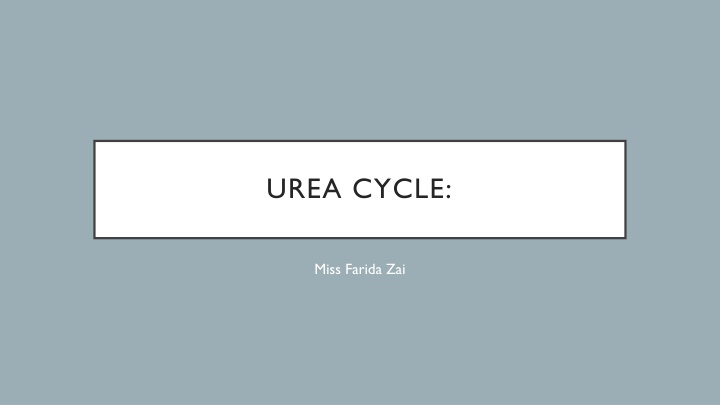
Urea Cycle - Biochemical Process for Ammonia Detoxification
Explore the Urea Cycle, a crucial biochemical pathway in ureotelic organisms that converts toxic ammonia into urea for excretion, preventing hyperammonemia and related health issues. Learn about the steps involved and the significance of eliminating excess ammonia from the body.
Download Presentation

Please find below an Image/Link to download the presentation.
The content on the website is provided AS IS for your information and personal use only. It may not be sold, licensed, or shared on other websites without obtaining consent from the author. If you encounter any issues during the download, it is possible that the publisher has removed the file from their server.
You are allowed to download the files provided on this website for personal or commercial use, subject to the condition that they are used lawfully. All files are the property of their respective owners.
The content on the website is provided AS IS for your information and personal use only. It may not be sold, licensed, or shared on other websites without obtaining consent from the author.
E N D
Presentation Transcript
UREA CYCLE: Miss Farida Zai
UREA CYCLE The urea cycle is a cycle of biochemical reactions that produces urea (NH ) CO from ammonia. This cycle occurs in ureotelic organisms. The urea cycle converts highly toxic ammonia to urea for excretion.
PURPOSE OF UREA CYCLE: The main purpose of the urea cycle is to eliminate toxic ammonia from the body. About 10 to 20 g of ammonia is removed from the body of a healthy adult every day. A dysfunctional urea cycle would mean excess amount of ammonia in the body, which can lead to hyperammonemia and related diseases.
STEPS OF UREA CYCLE: 1 Transport of nitrogen to the liver: Ammonia is very toxic, particularly to the central nervous system. The concentration of ammonia and ammonium ions in the blood is normally very low. (NH3+ H+ NH4+) Ammonia travels to the liver from other tissues, mainly in the form of alanine and glutamine. It is released from amino acids in the liver by a series of transamination and deamination reactions. Ammonia is also produced by bacteria in the gut and travels to the liver via the hepatic portal vein.
STEPS OF UREA CYCLE Reactions of the urea cycle NH4+and aspartate provide the nitrogen that is used to produce urea, and CO2provides the carbon. Ornithine serves as a carrier that is regenerated by the cycle. Carbamoyl phosphate is synthesized in the first reaction from NH4+, CO2, and two ATP. Inorganic phosphate and two ADP are also produced. Enzyme: carbamoyl phosphate synthetase I, which is located in mitochondria and is activated by N-acetylglutamate.
STEPS OF UREA CYCLE Ornithine reacts with carbamoyl phosphate to form citrulline. Inorganic phosphate is released. Enzyme: ornithine transcarbamoylase, which is found in mitochondria. The product, citrulline, is transported to the cytosol in exchange for cytoplasmic ornithine. Citrulline combines with aspartate to form argininosuccinate in a reaction that is driven by the hydrolysis of ATP to AMP and inorganic pyrophosphate. Enzyme: Argininosuccinate synthetase
STEPS OF UREA CYCLE Argininosuccinate is cleaved to form arginine and fumarate. Enzyme: argininosuccinate lyase. This reaction occurs in the cytosol. The carbons of fumarate, which are derived from the aspartate added in reaction 3, can be converted to malate. In the fasting state in the liver, malate can be converted to glucose or to oxaloacetate, which is transaminated to regenerate the aspartate required for reaction 3. Arginine is cleaved to form urea and regenerate ornithine. Enzyme: arginase, which is located primarily in the liver and is inhibited by ornithine. Urea passes into the blood and is excreted by the kidneys. Ornithine is transported back into the mitochondrion (in exchange for citrulline) where it can be used for another round of the cycle.
STEPS OF UREA CYCLE When the cell requires additional ornithine, it is synthesized from glucose via glutamate. Arginine is a nonessential amino acid in adults. It is synthesized from glucose via ornithine and the first four reactions of the urea cycle.
RELATED DISEASES TO UREA CYCLE IMBALANCE: The following conditions might take place; Hyperammonemia occurs when there is a deficiency in one of more of the urea cycle enzymes, causing insufficient removal of NH4+. Ammonia intoxication leads to CNS deterioration in the form of mental retardation, seizure, coma, and death.



![Lec [2] Health promotion](/thumb/274962/lec-2-health-promotion-powerpoint-ppt-presentation.jpg)
